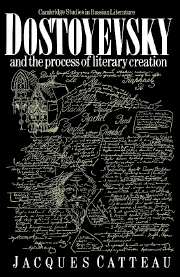Book contents
- Frontmatter
- Contents
- Preface to the English edition
- List of abbreviations
- General editor's note on transliteration and references
- General introduction
- PART I The creative environment
- PART II The process of creation
- Part III Time and space in the world of the novels
- Conclusion
- Notes
- Select bibliography
- Index of names
Preface to the English edition
Published online by Cambridge University Press: 18 December 2009
- Frontmatter
- Contents
- Preface to the English edition
- List of abbreviations
- General editor's note on transliteration and references
- General introduction
- PART I The creative environment
- PART II The process of creation
- Part III Time and space in the world of the novels
- Conclusion
- Notes
- Select bibliography
- Index of names
Summary
‘In the last thirty years’, as J. L. Backès remarked, ‘Dostoyevsky has inspired numerous books and studies, many of them excellent … The irritating question of technique remains. Dostoyevsky is obviously an artist, but this has never been clearly shown.’ If my work has any claim to originality – and here the reader must be the judge – it is in showing the technique of the novel and, more generally, Dostoyevsky the artist at work. I have reversed the procedure adopted by most literary critics, such as Vyacheslav Ivanov, L. P. Grossman and M. Bakhtin, who use the finished novels to infer Dostoyevsky's literary vision. With the advantage of writing after the complete, or almost complete, publication of the manuscripts of Dostoyevsky, I was able to begin with the first hints of creation, the sketches, the rough drafts and their various states, and to track the writer as he worked, in an attempt to grasp his creative logic. The birth of the novel, the writer as artist, is the main subject of this book. Naturally, since no technique exists without its metaphysics, analysis of the creative process led me to the great structures of the finished work, to the poetics of Dostoyevsky.
My book appeared in French at the end of 1978, to be followed almost immediately by further volumes of the great Soviet Academy Edition and by other works of scholarship. Without changing my basic ideas, which depend on the text of the novels, I felt it necessary to modernise, and so have standardised the references and provided a selective bibliography, noting essential works as well as newer contributions which relate to my own research.
- Type
- Chapter
- Information
- Dostoyevsky and the Process of Literary Creation , pp. xi - xiiPublisher: Cambridge University PressPrint publication year: 1989

